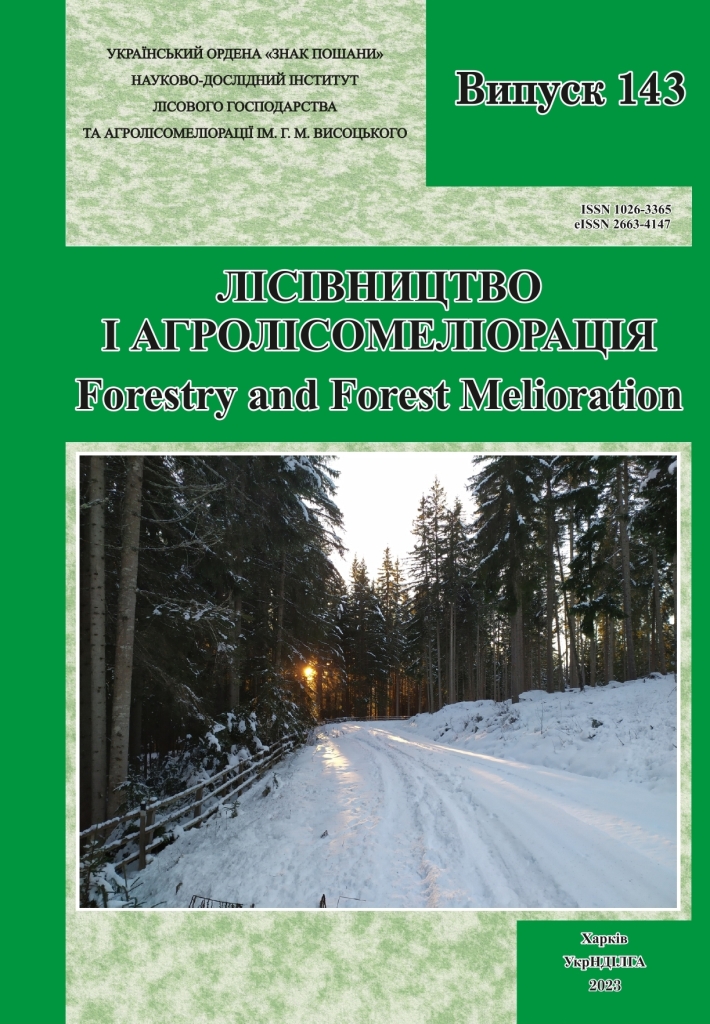Abstract
Introduction
In the past years, considerable information from Europe and North America has been accumulated about recreational and health-improving forests. In Ukraine, several studies were devoted to this topic. However, much less is known about the resources of these forests, which limits their effective use. Therefore, the assessment of stand characteristics of recreational and health-improving forests of various natural zones and the estimation of the extent to which the forests use the forest site capacity are urgent issues.
Materials and Methods
Forest mensuration characteristics of pine stands in recreational and health-improving forests in Left-Bank Polissia were analyzed based on the materials of the database “Forest Fund of Ukraine” of the Ukrainian State Forest Management Planning Association Ukrderzhlisproekt (as of 2017). The effectiveness of the use of forest site capacity was assessed by comparing the stocks of modal pine stands with those of highly productive stands.
Results
The area of pine stands in recreational and health-improving forests of the Left-Bank Polissia is about 47,000 hectares. Among the pine forests, stands of artificial origin predominate, covering 75% of the total area. The stock of these stands is estimated at 11.5 million m3. The proportion of pine stands belonging to forest areas in green zones around settlements (forestry part) is the largest and amounts to 61%. The productivity of natural stands is somewhat higher than that of artificial ones. This is primarily due to their higher average age. In general, among all studied pine forests, regardless of origin, the largest stock (345 m3·ha-1) was recorded for pine stands within the forest areas in green zones around settlements (forestry part), and the smallest one (246 m3·ha-1) for pine stands belonging to forest areas within cities, towns, and other settlements.
Modal pine stands lag behind highly productive stands in all age classes. For example, at the age of 100, the difference in stock between these stands is 29%.
The level of use of forest site capacity by modal pine stands ranged from 40% (at the age of 20) to 74% (at the age of 90–100) in comparison with local highly productive stands. In general, the weighted average value of the use of forest site capacity is relatively low and amounts to 67%.
Conclusions
The conditions of the studied region are generally favorable for the successful growth and development of pine stands with recreational and health-improving functions. This is evidenced by the significant predominance of pine trees that grow according to the first and higher site classes and have a relative density of stockings of 0.7–0.8. A decrease in the relative density of stocking for pine stands after reaching 80–90 years of age was revealed, regardless of location.
The weighted average values of the use of forest site capacity by modal pine stands in the forest areas in green zones in Left-Bank Polissia are relatively low and amount to 67%, compared to local highly productive stands.
6 Figs., 7 Tables, 14 Refs.
References
Bondar, O. and Tsytsiura, N. 2021. Recreational and health-improving forests of Kremenets district, Ternopil region. Balanced Nature Management, 2: 80–87 (in Ukrainian).
Bondarenko, V. D. and Furdychko, O. I. 1994. Forest and recreation in the forest. Lviv, Svit, 232 p. (in Ukrainian).
Edwards, D., Jay, M., Jensen, F. S., Lucas, B., Marzano, M., Montagne, C., Pearce, A., Weiss, G. 2012. Public preferences for structural attributes of forests: Towards a pan-European perspective. Forest Policy and Economics, 19: 12–19.
Filyushkina, A., Agimass, F., Lundhede, T., Strange, N., Jacobsen, J. B. 2017. Preferences for variation in forest characteristics: Does diversity between stands matter? Ecological Economics, 140: 22–29.
Gensiruk, S. A., Shevchenko, S. V., Bondar, V. S., Shelyag-Sosonko, Y. R., Koval, Y. V., Zaytsev, V. T., Kravchuk, Y. P. 1981. Integrated forestry zoning of Ukraine and Moldova . Kyiv, Naukova dumka, 300 p. (in Russian).
Hansen, M. M., Jones, R., Tocchini, K. 2017. Shinrin-Yoku (Forest Bathing) and Nature Therapy: A State-of-the-Art Review. Int. J. Environ. Res. Public Health, 14(8): 851. https://doi.org/10.3390/ijerph14080851
Holubchak, O., Korol, S., Melnychuk, I., Prykhodko, M. 2019. Optimization of forest ecosystem recreational services formation in conditions of decentralization in Ukraine. Advances in Economics, Business and Management Research: 2019 7th International Conference on Modeling, Develop-ment and Strategic Management of Economic System (MDSMES 2019). Ivano-Frankivsk, Ukraine, p. 5.
Musienko, S. I., Lukyanets, V. A., Bondarenko, V. V., Rumiantsev, M. H., Kobets, O. V. 2020. Typological diversity of recreational and health-improving forests in Left-bank Ukraine. Scientific Bulletin of UNFU, 30 (5): 31?35 (in Ukrainian).
Myklush, Yu. S. 2013. Determining the characteristics of landscape and valuation assessment of recreational and health-improving forests. Scientific Bulletin of UNFU, 23 (12): 14?25 (in Ukrainian).
Parpan, T. V., Holubchak, O. I., Hudyma, V. M., Prykhodko, N. F., Falko, R. I., Kyrylenko Ya. O. 2021. Characteristics of recreation forests of Ivano-Frankivsk region and assessment of their potential at permanent research sites. Scientific Bulletin of UNFU, 31 (5): 9?16 (in Ukrainian)
Pintilii, R.-D. 2022. Forest Recreation and Landscape Protection. Forests, 13: 1440.
Procedure for Dividing Forests into Categories and Allocation of Specially Protected Forest Areas. 2007. [Electronic resource]. Resolution of Cabinet of Ministers of Ukraine. No 733 dated 16.05.2007. Available at: https://zakon.rada.gov.ua/laws/show/733-2007-%D0%BF#Text (accessed 22.10.2023) (in Ukrainian).
Sanchez-Badini, O. and Innes, J. L. 2019. Forests and trees: A public health perspective. Sante publique (Vandoeuvre-les-Nancy, France), S1(HS): 241–248.
Tkach, V. P., Kobets, O. V., Rumiantsev, M. Н. 2018. Use of forest site capacity by forests of Ukraine. Forestry and Forest Melioration, 132: 3–12 (іn Ukrainian).

This work is licensed under a Creative Commons Attribution 4.0 International License.
